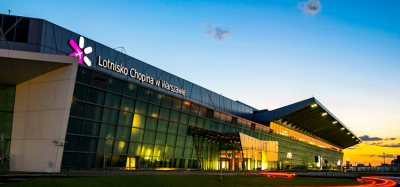International Airport Review live from ACI Europe’s General Assembly 2017
- Like
- Digg
- Del
- Tumblr
- VKontakte
- Buffer
- Love This
- Odnoklassniki
- Meneame
- Blogger
- Amazon
- Yahoo Mail
- Gmail
- AOL
- Newsvine
- HackerNews
- Evernote
- MySpace
- Mail.ru
- Viadeo
- Line
- Comments
- Yummly
- SMS
- Viber
- Telegram
- Subscribe
- Skype
- Facebook Messenger
- Kakao
- LiveJournal
- Yammer
- Edgar
- Fintel
- Mix
- Instapaper
- Copy Link
Posted: 13 June 2017 | Airports Council International (ACI) Europe, International Airport Review | No comments yet
ACI Europe addresses the state of the airport industry with a focus on the immediate and longer-term outlook for its 500-strong airport membership spanning 45 countries.


Air traffic developments
2016 saw Europe’s airports welcome more than 2 billion passengers for the first time, following 3 years of sustained growth in excess of +5%. Accordingly, Europe’s airports have added more than 300 million passengers since 2013 – making a significant contribution to the economy together with airlines and other aviation partners.
Olivier Jankovec, Director General ACI Europe commented:
“In the EU alone, passenger traffic has expanded by +22.2% since the global financial crisis – 3 times faster than GDP. This primarily reflects wider dynamics in the travel & tourism industry, driven by digitalisation, experiential consumerism, rising inbound demand from emerging markets, affluent baby boomers and ultra-mobile millennials in Europe. Conversely, freight traffic has only grown by +7.7% since 2008, hampered by slower trade, the multiplication of protectionist measures and supply chain relocations.”
So far this year, passenger traffic continues to be extremely dynamic, growing at +9% since January, and freight traffic has finally picked up, at +7.4%. This surge in air traffic is mainly driven by a synchronised uplift in the global economy, continued airline capacity expansion as well as demand recovery in Russia, Turkey and other markets hit by terrorism last year – in particular Belgium and France. So far, air traffic is clearly defying increased geopolitical risks, much like the rest of the economy. However, Europe’s airports reiterated their concerns at the ongoing uncertainty resulting from the UK leaving the European Union – uncertainty which has only increased following the results of the UK election last week.
Economic & financial performance
The financial performance of Europe’s airports continues to improve, with the industry’s average return on invested capital (ROIC) now standing at +7.7% – in line with the cost of capital. However, airports in the Eurozone keep underperforming (+6.1%), and the performance gap is even wider when compared to airports in the BRICS or other emerging markets (+9.7% and 12.2% respectively).
Jankovec commented:
“There is no doubt that the growth in air traffic has helped, but the sharp focus of airports on efficiencies and costs reductions has been instrumental in delivering improved financials. Costs have fallen by -8% on a per passenger basis since 2008, with staff costs alone going down by an impressive -22.8%. Containing costs is a must, given the challenging revenue environment we are facing. Total revenues have remained almost flat on a per passenger basis since 2008. The fact that Low Cast Carriers are driving growth comes with ever-present pressure on aeronautical revenues. On top of that, changing consumer behaviours and online competition in both retail and advertising mean strong headwinds in commercial revenue generation.”
47% of Europe’ airports are loss making, compared to 60% in 2013. However, smaller regional airports have not seen their finances improving, as evidenced by the fact that 76% of them remain loss making – a percentage almost unchanged over the past 3 years. With Low Cost Carriers having moved upmarket and airlines generally focusing on primary & larger markets, network development opportunities and revenue generation are becoming harder to secure for these airports – while years of cost-cutting limits further efficiency gains.
Low cost revolution marching on & airport competition
Once a reality mainly for regional airports, airport competition has now moved upmarket along with the expansion of Low Cost Carriers into primary markets & larger airports. Over the past 10 years, 99% of the growth in passenger traffic of the TOP20 European airports has been delivered by Low Cost Carriers. This clearly shows that whatever their size and location, Europe’s airports all end up chasing the same airlines and increasingly compete with each other.
Olivier Jankovec said:
“The Low Cost revolution is marching on – and nothing will stop it. Low Cost Carriers have moved into larger airports & hubs, and they are now making inroads into the long haul market. Europe’s airports will see 87 long haul routes being operated by Low Cost Carriers this summer, up from 14 just four years ago. The next step – which Ryanair has just started experimenting, is to offer feed to network carriers or even develop their own connecting product.”
He added: “More long haul direct routings by-passing larger hubs, but also new opportunities for airport to start acting as hubs are becoming a reality – primarily enabled by new & more efficient aircraft technology, affordable oil prices and business innovation. Ultimately, these developments might redefine what being a hub is, and they are already intensifying competitive pressures on larger airports.”
New air connectivity analysis
The increase in airport competition and its underlying causes also come with changing connectivity patterns. ACI Europe released today its 4th Airport Industry Connectivity Report*, which reveals that for the second year in a row, direct connectivity is growing at a faster rate than indirect and hub connectivity. Once again, this reflects the expansion of LCCs on both short/medium haul and long haul markets and the relative retrenchment of network carriers¹.
Amsterdam-Schiphol has become the number 1 airport in Europe in terms of direct connectivity, overtaking London-Heathrow. Since 2007, Moscow-Sheremetyevo, Palma de Mallorca and Dublin have joined the TOP20 European league for direct connectivity – while Istanbul-Atatürk has moved from the 20th to the 5th position.
Frankfurt, Amsterdam-Schiphol, Paris-Charles de Gaulle and Istanbul-Atatürk remain at the very top of the global ranking for hub connectivity – along with Dallas-Fort Worth and Atlanta. However, Middle East and Asian airports have seen their hub connectivity grow exponentially since 2007 – redefining the hub competition landscape².
Hub competition is also evident and growing within Europe, where a number of secondary hubs have emerged over the past 10 years. These include Dublin, Dusseldorf, Warsaw and Berlin-Tegel, which have replaced Milan-Malpensa, Barcelona-El Prat, Prague and Stockholm-Arlanda in the TOP20 league of European Hubs in terms of the hub connectivity they offer. Apart from Istanbul-Atatürk, Moscow-Sheremyetevo and Amsterdam-Schiphol which have progressed upward in the TOP20, Lisbon, Brussels and Helsinki have further reinforced their hub status3.
To download the Airport Industry Connectivity Report 2017, go to:
https://www.aci-europe.org/component/downloads/downloads/5094.html
¹ Since 2007, direct connectivity offered by LCCs on intra-European routes has increase by +175.6% while it decreased by -11.7% for network carriers. On long haul markets out of Europe, LCCs increased their direct connectivity by +146% and network carriers by +30.6%.
² See graph on Page 18 of the report: Hub connectivity – top 20 world airports
3 Hub connectivity growth since 2007 – Abu Dhabi: +1,479%, Delhi: +904%, Guangzhou: +897%, Doha: +806%, Dubai: +306%. See graph on Page 19 of the report: hub connectivity 2017 – top 20 fastest growing world airports
Related topics
Aeronautical revenue, Air traffic control/management (ATC/ATM), Brexit, Capacity, Economy, Passenger volumes, Regulation and Legislation, Sustainable development, Terminal operations


















